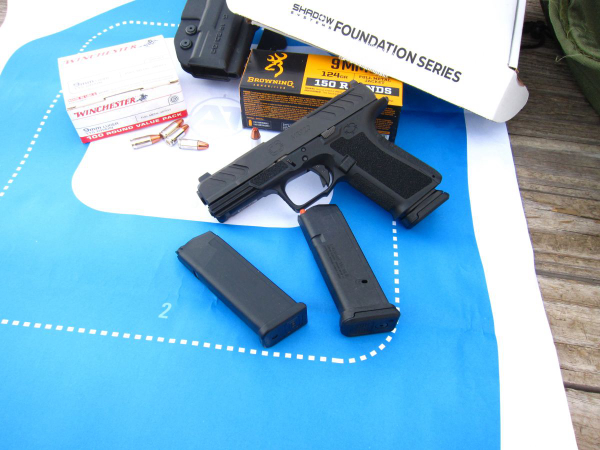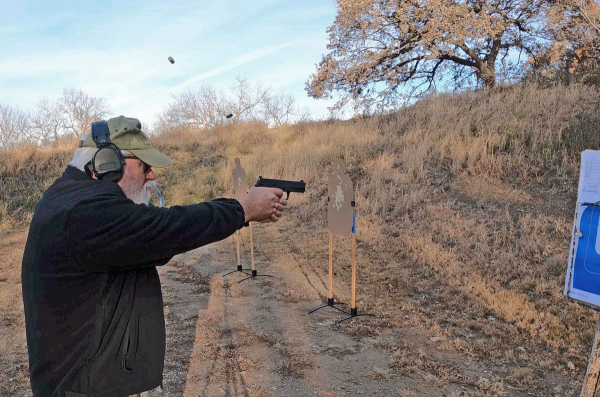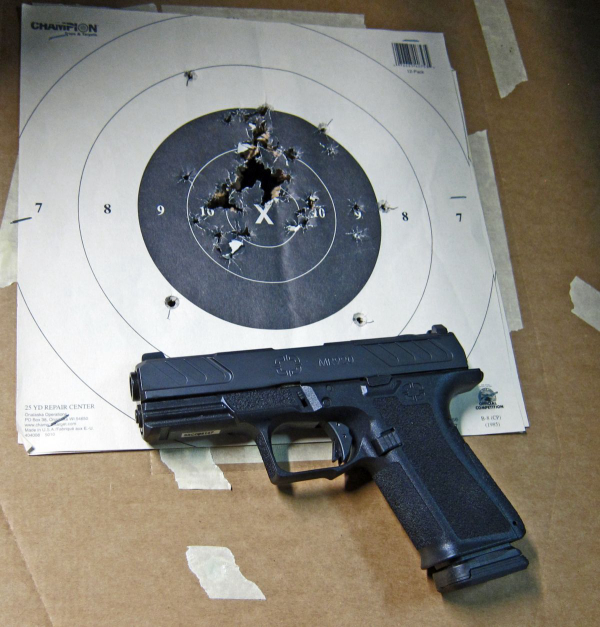The latest test attempts with the “box of Shadow Systems pistols” saw the use of the service/compact or “Multi Role” size Shadow Systems pistol. Like others in the classification, this is a fifteen shot 9mm with a four-ish inch barrel. The difference, as indicated in coverage of the crossover (XR) pistol, is that the pistol is a high end striker fired auto – but a “Foundation” version of the Shadow Systems line.

Starting at $679 MSRP, that puts them in the ballpark with the mass-produced “standard factory” autos as far as pricing and feature set goes. Made to fit “Gen4” holsters for the G19/G19x and taking GLOCK magazines (they ship with the MAGPUL product), it’s clear that they intend the MR920 Foundation to fit in with a range of existing aftermarket support.
There’s less of the fancy machining, cut-outs and serrations, but all of the advantages of the frame shape and features that appear in Shadow Systems’ premium lines.
The rear sight is serrated for glare reduction and there’s a white dot on the front sight, a smart setup. The 9mm striker-fired pistol has a fifteen round standard capacity with a trigger specified at 4.5-5 pounds of pressure to release. The barrel and slide are nitride finished.
On the first range trip with the MR920 “Foundation” series pistol, I used the Comp-Tac International Holster with paddle attachment. I checked the zero first, from fifteen yards, standing off-hand. I put the “dot” on the front sight on the bull and hit above it – about where the top of the front sight was being held.
The first evaluation rounds fired were on a basic proficiency test designed for the concealed carry practitioner. I’m not sure the course is ready for prime time – and don’t have permission to divulge details.

I can say that the test uses two IDPA targets set six feet apart edge-to-edge. The test is scored as an aggregate of time plus a second per point “down.” The distances included five yards and seven yards. A cover garment is required.
I’d not been able to break the fifteen second barrier, normally due to one or two “out of the -0” penalties. That said, I got it done in 15.92 with two penalties with the new-to-me MR920.
That puts me square where I was with other guns that were more familiar to me.
I followed it by shooting Justin Dyal’s “Five-Yard Roundup” on a B-8 bullseye. The times were fine, but I got crazy on the strong-hand only stage, throwing one into the 7 and one just outside the 7.
That’s not the gun’s fault.
On my standard CQ course, the high percentage stage had three strings over time, with good hits. The FDLE Stage 2 featured pairs from guard in .98, .96 and .96. The Bakersfield PD course featured the following times: 1.47, 1.63, 5.41 and 3.59 (down 1, left at 9 o’clock).
The pistol was cooking right along.


I did some shooting on a mashup of a previous FBI Qual course along with the long distance (50 yard) stage – which put me down three points at that beginning distance. I followed up with two strings from 25 yards before moving up to three yards.
It was there, on the “3 strong hand unsupported-3 weak hand unsupported” string that I got my first failure to fire with this gun.
It’d happened with the XR920 as well. I thought it was, perhaps, the light recoil impulse of the ammo not letting the slide get all the way back into battery caused light strikes. During the 7 yard strings of fire, I experienced two more failures to fire with another at fifteen yards. I shot a 93% with the gun, but it was clearly capable of better work.
My next trip saw me using the same ammo, the Browning Branded-Winchester-headstamped 124gr. FMJ. Likewise, I used the Comp-Tac holster and added a GLOCK OEM magazine along with the pair of Magpul mags supplied by the factory.
I elected to shoot the ‘rimfire’ version of the LFI-MAG40 handgun qualification course on a B-8 repair center stapled over the center of an IDPA target. Times were recorded, as were hits for each stage.
The recurrent Shadow Systems-Browning/Winchester ball “failures to fire” plagued the shooting. Going by rimfire scoring for the 60-round course, it was a 295/300, with all but five rounds going inside the shaded portion (9-ring and inside) of the B-8 repair center. As the five outliers were all in the “8” ring, each scored one point down.
The over-time due to a failure to fire on the first shot of the first stage knocks that down to 290, but the other failures to fire were remediated in time.
The first stage yielded six hits, thus: one in the “X,” 1 in the “8” and four inside the “10” ring. The second stage, was nearly eight seconds consumed with the second failure to fire. Another pair inside the “8” ring were recorded, with the rest in the bull.
All shots fired from seven yards, including the extra loaded to account for the third failure to fire, were in the “black.” At ten and fifteen yards, there were no failures to fire. As the round from seven yards never was made to fire, I’m seeing this is likely an ammo issue. I’ll keep track of that as all the ammo was purchased from Academy Sports in packaging I’ve only seen there.

It’s good practice for remediating stoppages, but it doesn’t raise confidence in the gun in which it happens. And I’ve not seen this before in other guns.
So how’s this Foundation gun doing? In terms of accuracy and non-failure to fire stoppages, wonderfully. Using the MAG qual for this outing, with mandatory reloads after the first two stages, plus the reload drills done on the first outing, I’m finding the gun-handling aspect of the Foundation guns to be great fun. Everything is where it needs to be. While it “feels” vastly different from the G19 I’ve worked with for 21 years, it doesn’t work differently.
That’s not nothing.
-- Rich Grassi